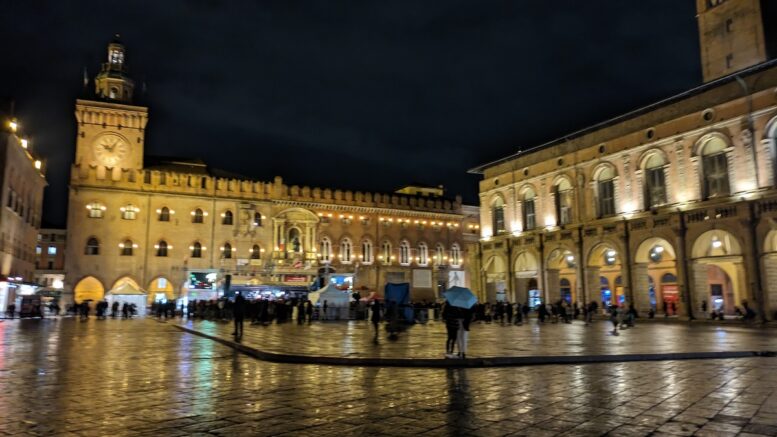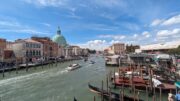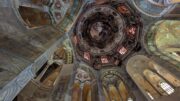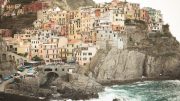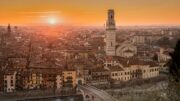It’s the afternoon rush hour traffic and I’m in a taxi cruising towards the city center of Bologna, with buses, cars, and motorcycles zooming along all sides of us. I’ve been awake for 36 hours when I first get a glimpse of ruins. Bologna used to be a walled city, and its remnants of the former walls are the first glimpse of the old city that I see. Just a few miles farther is the apartment of a friend of my partner, where we will be staying in a modern area of the city. The way that the ancient and the new can coexist is just one of the wonderful and magical things about a city like Bologna that’s existed since about 3,000 years before Christ.
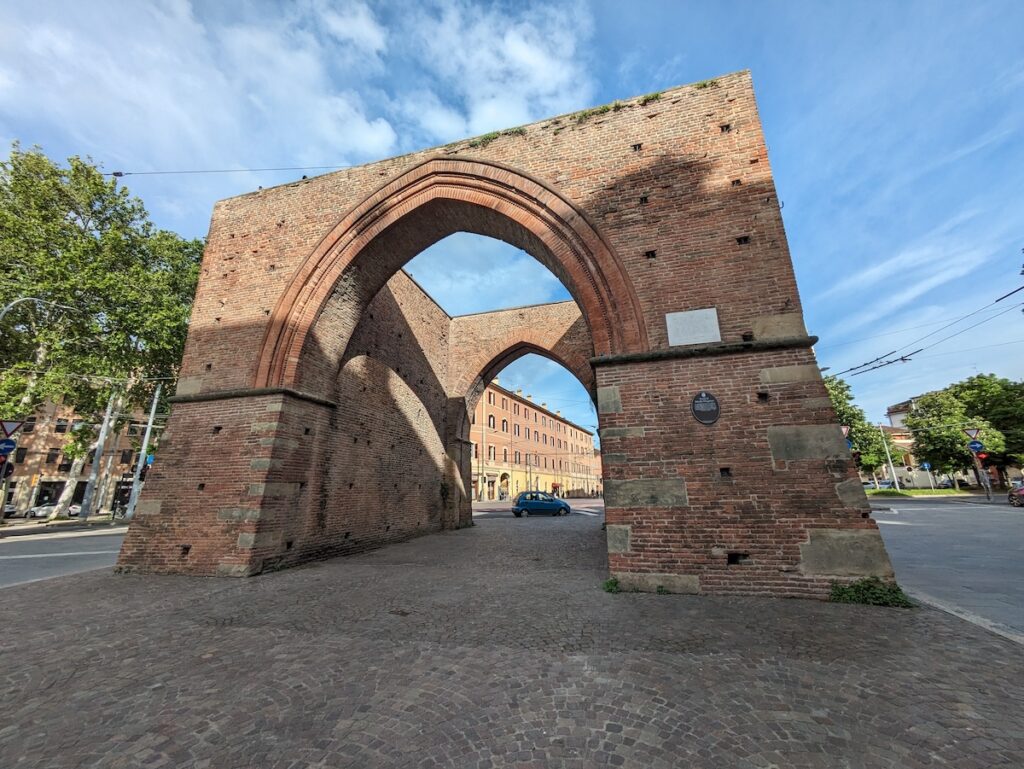
Part of the walls of the old city.
Bologna, the vibrant capital of Emilia-Romagna in northern Italy, isn’t exactly a hidden gem. It’s the 7th most populous city in Italy and the University of Bologna, in continuous operation since in 1088, has the claim to fame of being the oldest university in the world. But it doesn’t have the crowds of Rome or Venice and has so much of its own to see. As a plus, it’s a short train ride away from Venice, Parma, Florence, and Ravenna, making it a great home base. Bologna has a walkable city center, mouthwatering food (hello, pasta lovers!), easy public transport, and enough historical and cultural attractions to keep everyone entertained. We recently visited Bologna, Venice, and Ravenna for the first time, and we loved it.
Pro tip: Ample opportunities for employment make Italy a desirable place to live. And, for many, that means becoming a resident. For assistance gaining citizenship in Italy, you’ll want to start with a team of experts who can make the process a seamless one.
A Foodie Paradise for All Ages:
Let’s be honest, when it comes to family travel, food is a major factor. And Bologna takes the cake (or should we say, the tortellini?) This city is not yet a UNESCO World Heritage Site for Gastronomy, but it should be — and in fact may be soon. In March 2023, the city submitted a bid to be recognized and should get a response in 2025. The city is known for food, from the iconic Bolognese ragu to creamy gelato and melt-in-your-mouth mortadella, Bologna is a feast for the senses.
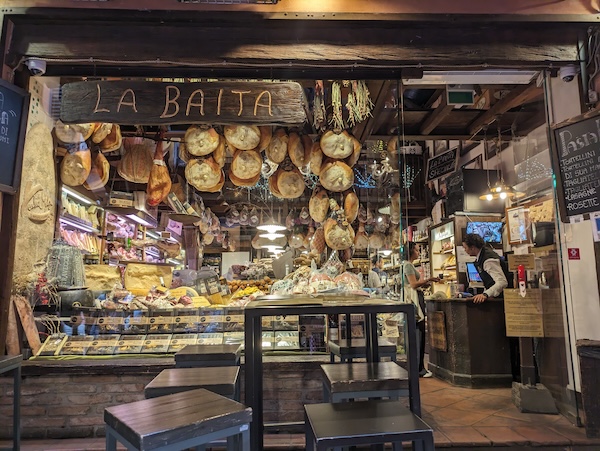
It’s impossible to not find good food in Bologna.
Exploring Bologna
Bologna’s historic center is a delight to explore on foot. One thing it is recognized for is the unique architecture of its medieval porticoes — which have been recognized as a World Heritage Site since 2021. We were there in late April and early May, which is just the very beginning of the tourist season. The weather was mostly mild, and there was a mix of clouds and sun. Although it did rain a little, I packed my rain jacket and actually never ended up wearing it. I brought a sweater and a knitted sweater poncho, which is an item I take with me on almost every trip. I put that on as an extra layer and didn’t have to carry my rain jacket. I was warm enough without it.
There are so many porticos, about 24 miles of porticoes in the city’s historical center and about 28 miles throughout the city, that you can walk for long distances without getting rained on. If you’re traveling with young children, there are plenty of cafes, gelato shops, and pizzerias on almost every block so you can take a break whenever you need to.
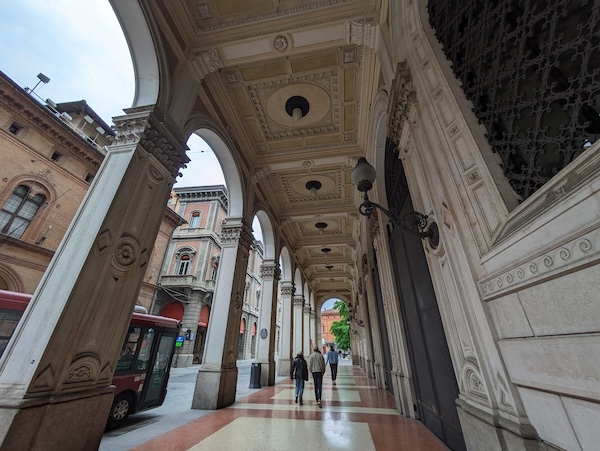
Some of Bologna’s famous porticos.
Taking the bus is easy. There’s an app that can tell you the schedules. Once on board, drop coins into the pay meter or tap the meter with your debit card or phone app and you’re set to ride.
History Comes Alive
Some of the fascinating things to do in Bologna are the Anatomical Theatre at the university, which is where the medical students learned how bodies work.
Like most Italian cities, Bologna has its share of churches and art. The Basilica di San Petronio is the largest (Gothic or otherwise) church built of bricks of the world. One cool thing about this church is that it has meridian lines on the floor. If you don’t know they are there, you might miss it. Inlaid in the floor in 1655 following the calculations of the astronomer Giovanni Domenico Cassini, who was teaching astronomy at the university. The meridian line is one of the largest astronomical instruments in the world.
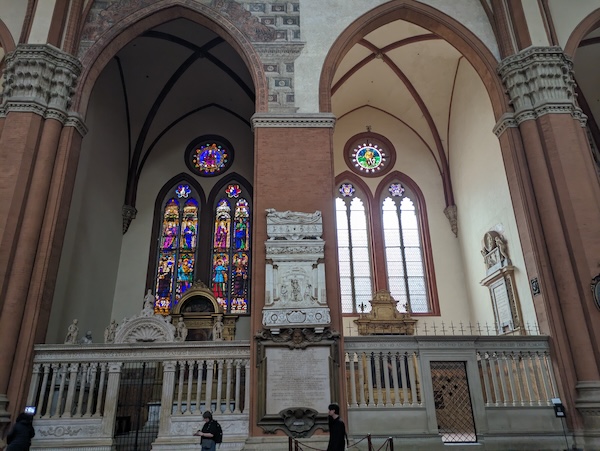
Wealthy families built their own chapels, or cappella, inside churches, such as these inside the Basilica di San Petronio. The wealthiest families had more ostentatious chapels.
The Basilica of Santo Stefano was built around 100 AD on the site of a natural spring where a temple dedicated to Isis used to stand. If you want to see Renaissance and Medieval art, the churches are where you will find it. But remember that these are not museums. They are churches that still hold services. If you are not dressed somewhere conservatively you may not be allowed in. If your group is talking loudly or being disrespectful, you will be asked to leave. You will be asked to remove any hats.
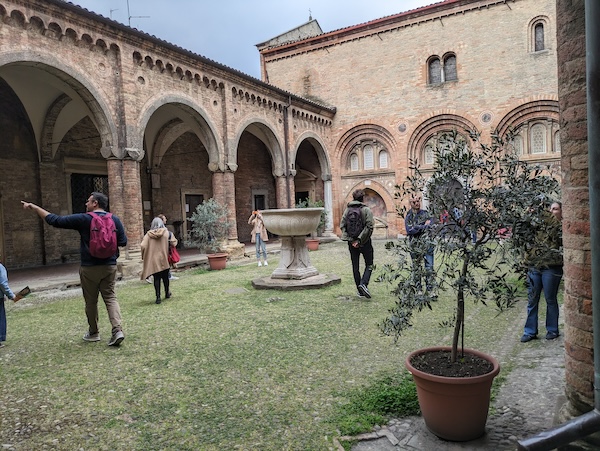
This limestone basin in the courtyard of the Basilica di Santo Stefano dates back to 740 AD.
Bologna’s Piazza Maggiore (“Major Plaza”) is lined with arched porticos, cafes, and lots to look at such as the Fountain of Neptune and the Basilica di San Petronio. Among the city’s many medieval sites are the Due Torri, or Two Towers, the two most prominent of the many medieval towers that used to dominate the city. The taller tower is called the Asinelli, and the smaller, more leaning tower is called the Garisenda. Both were built between 1109 and 1119 and were originally constructed by wealthy families for defense and protection.
The Basilica di San Domenico contains the Arca di San Domenico, which has three sculptures produced by Michaelangelo. One of the three is a candle holder in the form of a kneeling angel.
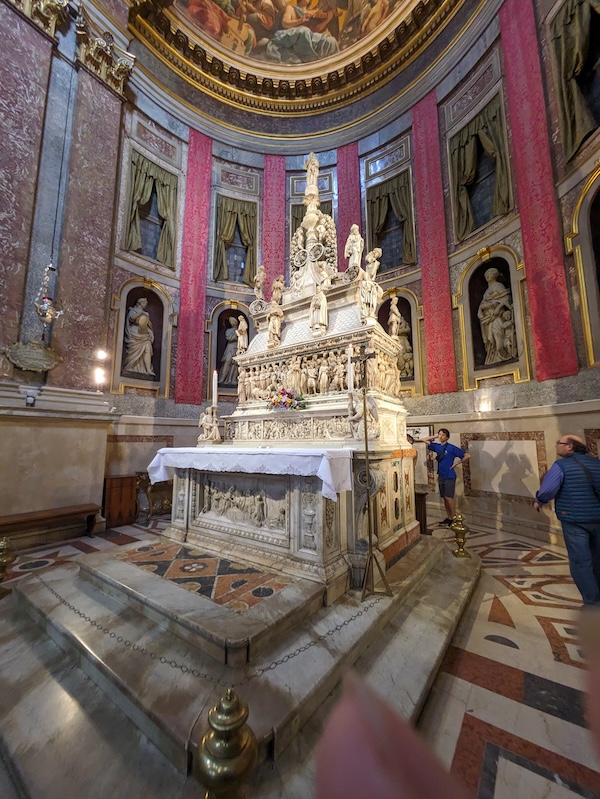
The Arca di San Domenico.

One of three sculptures made by Michaelangelo.
Bologna is the site of the Archaeological Museum, which is well worth a visit. We spent most of a day here wandering through the Roman, Egyptian, Greek, and Etruscan artifacts. There is so much on display in this museum, it’s almost overwhelming. This is a world-class museum where you see things from ancient antiquity that you would otherwise only see in textbooks. Amazing.
Take a Food Tour in Bologna
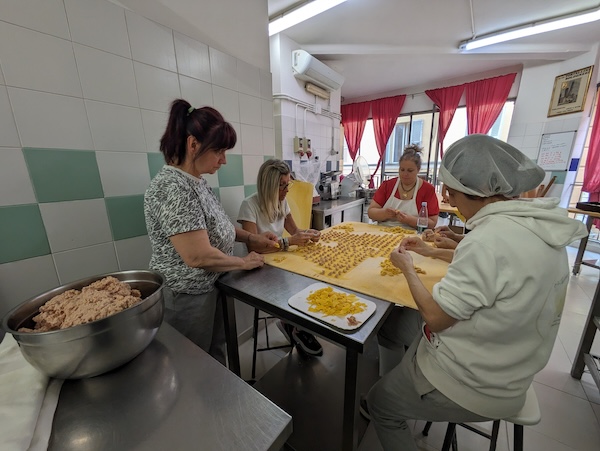
The guide of our food tour organized by Secret Tours of Bologna, Gabriel, was super friendly and took us to places we would not have found on our own. The tour ended in Osteria del Sole, a place with no sign outside. It’s been open since the 15th century and serves wine to people who bring in their own food. Over the course of the tour we tasted 12-year-old balsamic vinegar of Modena at Gilberto’s. Gabriel took us to a kitchen to watch a group make tortellini by hand, which is sold in nearly every shop. We tasted mortadella and other meats and cheeses, had true Bolognese ragu and tortellini in brodo (“in broth”), washed it down with delicious local wine, and finished with gelato.
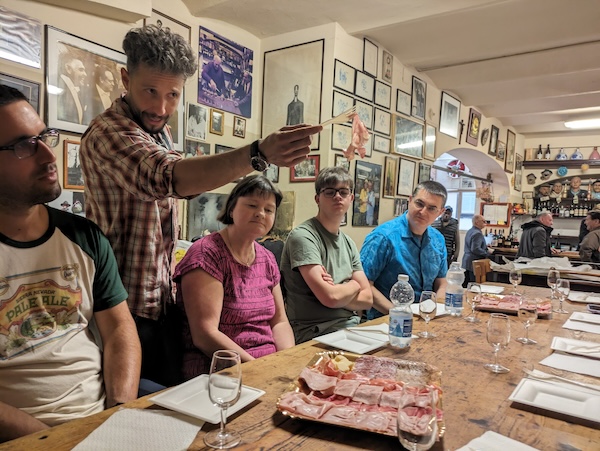
Our tour guide, Gabriel, demonstrating how thin the traditional mortadella is.
A tour is a great way to get to know a town, even if you only have a couple of hours. On our tour, we had a family who came to Bologna just for the tour. The ease of train travel here makes it easy to do things like this.
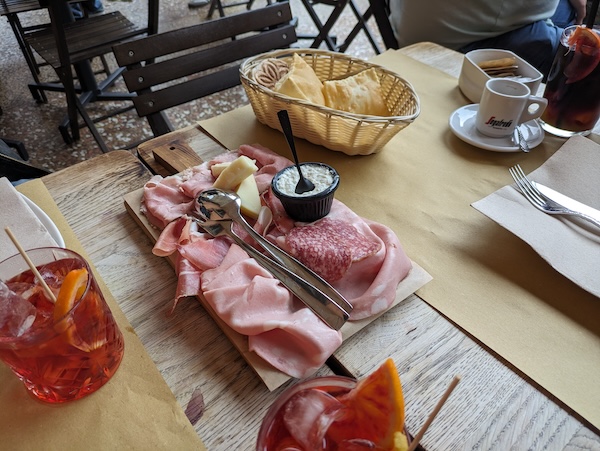
Bread, cheeses, meats, and negronis are ubiquitous in Bologna. These came from Osteria Santo Stefano.
Bologna is a city that caters to families. Kids are people, and people go out to eat, so there’s no reason to feel unwelcome if you have children with you. There are plenty of parks and squares where children can run and play. The city also hosts regular events and festivals throughout the year, to keep everyone entertained.
Book your Stay in Bologna
Planning Your Bologna Adventure
Bologna offers a variety of accommodation options to suit all budgets and family sizes. We got lucky and had an apartment to stay in that didn’t cost us anything. It was great to have that as a home base. Consider staying in an apartment with a kitchen, where you can go to the grocery store or stop at one of the numerous produce stands or fish stands and make your own meals.
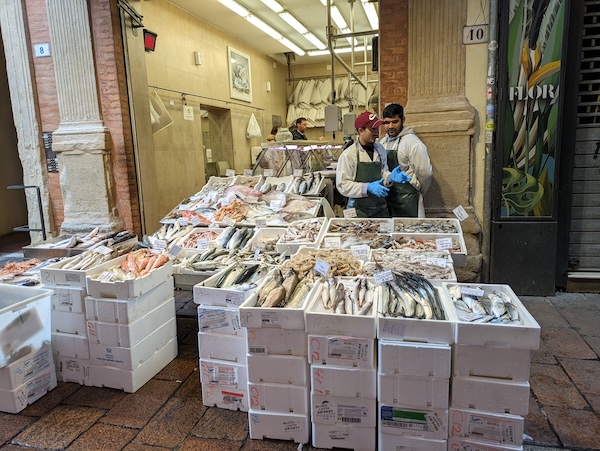
Even though food costs in restaurants are not as high as they are in the United States, going out to eat definitely adds up. We went to a pizza place nearby called Donna Margherita a couple of times. The pizzas cost about $10 for a 12-inch pizza. While restaurant plates are lower priced, they are also typically smaller portions, so you might not have as many leftovers as you would here in the US. Bologna is a pedestrian-friendly city, and many people ride scooters or bikes, so renting a car may not be necessary. Public transportation is efficient and affordable.

Holidays are a big deal here and while some restaurants and shops remain open, many others close. We were there for Primo Maggio, May 1, or Worker’s Day, and many shops were closed. There was also a large public event with speakers and concerts throughout the day in the Piazza Maggiore. (The header image shows the plaza set up for concerts and crowds into the night.)
If you do want to visit somewhere that requires a ticket for entry, try to book it ahead of time. You;ll save yourself time waiting in line. The first Sunday of the month, cultural attractions all across Italy are free, so you don’t have to pay but you also can’t choose an entry time. There are longer lines on these days, but if you’re on a budget, keep it in mind.
While you’re in Italy, especially if you’re traveling around by bus or train, try to keep an eye on any strikes that might be taking place. We wanted to take the train to Florence for a day, but there was a planned worker strike that could have affected the train, and we were afraid that missing the train would mess up our other plans, so we didn’t go. If something like this happens, keep a flexible mindset and you’ll be fine. On the day we had planned to go to Florence, we went to the Archaeological Museum instead, which was something we might not have taken the time to do otherwise. We loved it and that museum visit became a highlight of our trip.
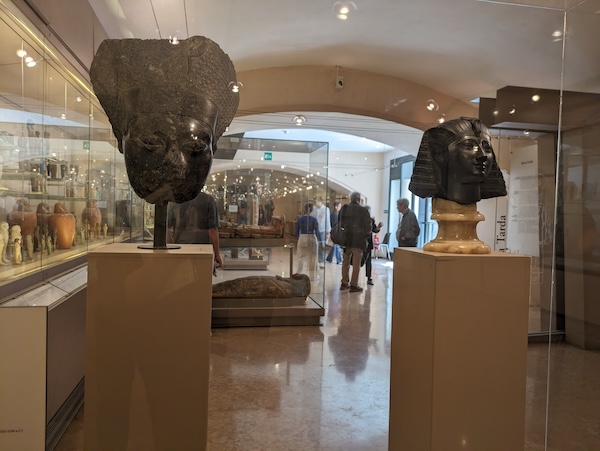
Vanessa Salvia is an accomplished freelance writer and editor with extensive experience creating high-quality content for various mediums. Her work spans writing articles for newspapers and magazines, crafting SEO-optimized web content, and assisting authors in polishing their book manuscripts. To learn more about her services and portfolio, visit vanessasalvia.com.

